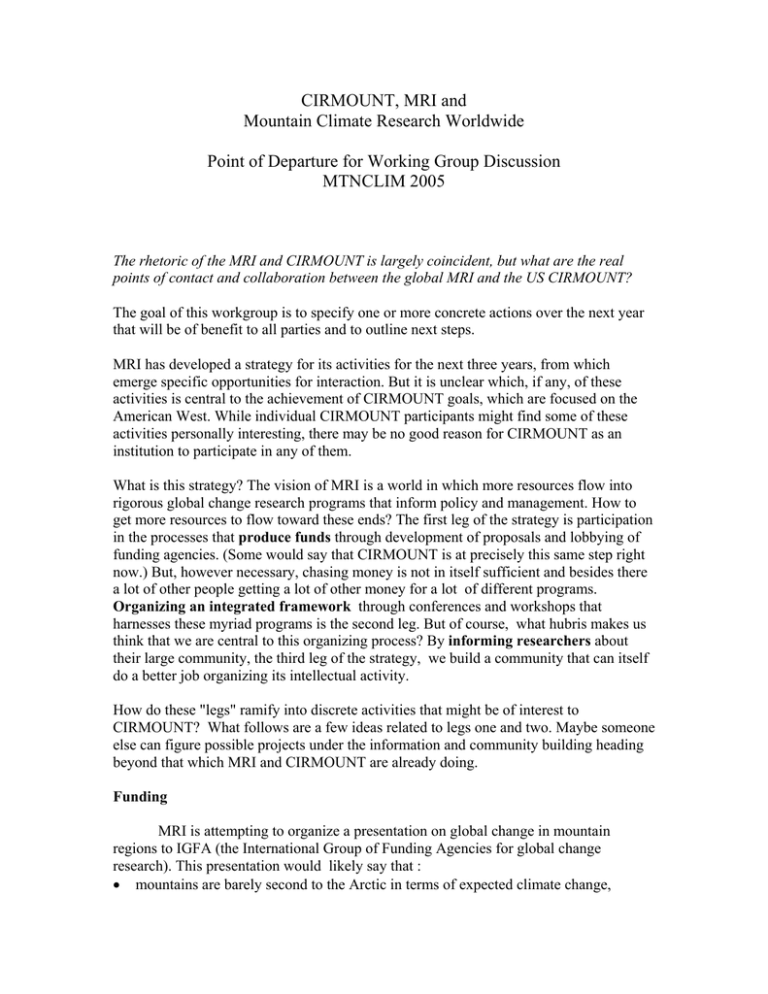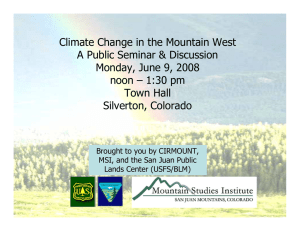CIRMOUNT, MRI and Mountain Climate Research Worldwide
advertisement

CIRMOUNT, MRI and Mountain Climate Research Worldwide Point of Departure for Working Group Discussion MTNCLIM 2005 The rhetoric of the MRI and CIRMOUNT is largely coincident, but what are the real points of contact and collaboration between the global MRI and the US CIRMOUNT? The goal of this workgroup is to specify one or more concrete actions over the next year that will be of benefit to all parties and to outline next steps. MRI has developed a strategy for its activities for the next three years, from which emerge specific opportunities for interaction. But it is unclear which, if any, of these activities is central to the achievement of CIRMOUNT goals, which are focused on the American West. While individual CIRMOUNT participants might find some of these activities personally interesting, there may be no good reason for CIRMOUNT as an institution to participate in any of them. What is this strategy? The vision of MRI is a world in which more resources flow into rigorous global change research programs that inform policy and management. How to get more resources to flow toward these ends? The first leg of the strategy is participation in the processes that produce funds through development of proposals and lobbying of funding agencies. (Some would say that CIRMOUNT is at precisely this same step right now.) But, however necessary, chasing money is not in itself sufficient and besides there a lot of other people getting a lot of other money for a lot of different programs. Organizing an integrated framework through conferences and workshops that harnesses these myriad programs is the second leg. But of course, what hubris makes us think that we are central to this organizing process? By informing researchers about their large community, the third leg of the strategy, we build a community that can itself do a better job organizing its intellectual activity. How do these "legs" ramify into discrete activities that might be of interest to CIRMOUNT? What follows are a few ideas related to legs one and two. Maybe someone else can figure possible projects under the information and community building heading beyond that which MRI and CIRMOUNT are already doing. Funding MRI is attempting to organize a presentation on global change in mountain regions to IGFA (the International Group of Funding Agencies for global change research). This presentation would likely say that : • mountains are barely second to the Arctic in terms of expected climate change, • • • such change will affect vastly more people than in the Arctic, Switzerland has supported global change research in mountain region as a matter of foreign, development and scientific policy, and wouldn't it be great if other countries similarly increased their funding for global change research in mountain areas. This argument seems to be one that CIRMOUNT is slowly framing within the context of the US federal budget process. A presentation to IGFA would provide a means of speaking directly, though not solely, to US NSF and other federal funding agencies about this topic. Frameworks The GLOCHAMORE program (MRI, UNESCO-MAB and the EU) is sponsoring an Open Science Conference on Global Change in Mountain Regions in Perth, UK on Oct 1-5, 2005. At its most basic level, the Conference provides an opportunity for exchange and communications. At another level it is the concluding step in the development of a research strategy applicable to mountain biosphere reserves. The development of a strategy may be among the next steps for CIRMOUNT, and therefore it may be helpful for CIRMOUNT to be more involved with this conference. A quick view of the expressions of interest show that around 10 CIRMOUNT-oise have inquired. No one from CIRMOUNT has expressed a desire to chair a session. Is CIRMOUNT interested in sponsoring a session? There is currently a lot of activity in Russia and Central Asia surrounding global change in those regions. Central Asia is arguably very similar to the western US: might there not be some merit in comparing notes with colleagues from Central Asia, Russia, Mongolia and China, perhaps at a session in Perth or in a stand-alone conference? Could we envision doing something similar for the American Cordillera, something that Henry Diaz is already working on? Finally, I personally am very interested in two potential symposia topics: -the current state of remote sensing in mountain environment: what can we get out of the sensors that are already out there, and -how does one use large transects or multiple sites (e.g the transect from the Olympics to the Rockies) to extract something more than the recognition that things differ from one place to another. The first topic is motivated largely my ignorance of how RS has progressed since about 1985, hence it may not be great interest to anyone else. But, then again, maybe it is. The second seems very important if we were ever to create widely dispersed mountain observatories.




